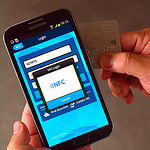Top story
Zurich, Switzerland, 18 October 2013—IBM scientists have developed a new mobile authentication security technology based on the radio standard known as near-field communication (NFC). The technology provides an extra layer of security when using an NFC-enabled device and a contactless smartcard to conduct mobile transactions, including online banking and digital signatures when accessing a corporate Intranet or private cloud.
 According to a new report by ABI Research, the number of NFC devices in use will
exceed 500 million in 2014. This statistic and the fact that 1 billion mobile phone users
will use their devices for banking purposes by 2017* make for an increasingly
opportune target for hackers.
According to a new report by ABI Research, the number of NFC devices in use will
exceed 500 million in 2014. This statistic and the fact that 1 billion mobile phone users
will use their devices for banking purposes by 2017* make for an increasingly
opportune target for hackers.
To address these challenges, IBM scientists in Zurich, also known for inventing an operating system used to power and secure hundreds of millions of smartcards, have developed an additional layer, a so-called two-factor authentication, for securing mobile transactions.
Today many consumers use two-factor authentication from a computer, for example, when they are asked for both a password and a verification code sent by SMS. IBM scientists are applying the same concept using a PIN and a contactless smartcard. The contactless smartcard could be a bank-issued ATM card or an employer-issued identity card to access a corporate Intranet or private cloud.
“Our two-factor authentication technology based on the Advanced Encryption Standard provides a robust security solution with no learning curve,” said Diego Ortiz-Yepes, a mobile security scientist at IBM Research.
How it works
The user simply holds the contactless smartcard next to the NFC reader of the mobile device and after keying in their personal identification number (PIN), a one-time code would be generated by the card and sent to the server by the mobile device. The IBM technology is based on end-to-end encryption between the smartcard and the server using the National Institute of Standards & Technology (NIST) AES (Advanced Encryption Standard) scheme. Current technologies on the market require users to carry an additional device, such as a random password generator, which is less convenient and in some instances less secure.
The technology, which is available today for any NFC-enabled Android 4.0 device, is based on IBM Worklight, a mobile application platform IBM acquired in 2012. Future updates will include additional NFC-enabled phones based on market trends.
About IBM MobileFirst
As the first new technology platform for business to emerge since the World Wide Web, mobile computing represents one of the greatest opportunities for organizations to expand their business. Based on nearly 1,000 customer engagements, more than 10 mobile-related acquisitions in the last four years, a team of thousands of mobile experts and 270 patents in wireless innovations, IBM MobileFirst provides the key elements of an application and data platform with the management, security and analytics capabilities needed for the enterprise.
To learn more, visit the IBM MobileFirst press kit or webpage. Follow @ibmmobile, #ibmmobile on Twitter, and see IBM MobileFirst on YouTube, Tumblr and Instagram.
*Mobile Banking, Handset & Tablet Market Strategies 2013-2017, Juniper Research.